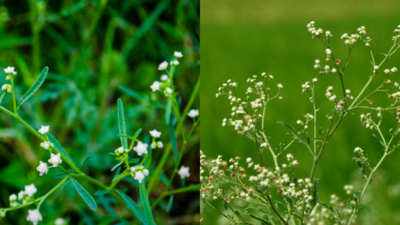- News
- lifestyle
- health-fitness
- health-news
- These harmless white flowers can cause serious respiratory illness in just anyone
Trending
These harmless white flowers can cause serious respiratory illness in just anyone
Parthenium hysterophorus, or Congress grass, is a rapidly spreading weed posing significant respiratory health risks. Originating from Central America, it releases a toxic chemical called parthenin, irritating the skin, eyes, and lungs. Exposure can trigger allergic rhinitis, asthma, and even severe lung conditions like hypersensitivity pneumonitis, affecting both outdoor workers and urban residents.
You’ve probably walked past it without even knowing. That bushy, white-flowered weed growing by the roadside, in open plots, or in your garden? That’s Parthenium hysterophorus, also called Congress grass. Looks harmless, right? But don’t be fooled—this green invader is a silent troublemaker. Especially for your lungs.
Let’s break it down and see how this common plant can cause serious respiratory illnesses—and what you can do to stay safe.
What is Parthenium?
Poll
Did you know this common roadside weed could harm your lungs?
How does it affect your lungs
Some common respiratory issues caused by Parthenium exposure include allergic rhinitis (sneezing, nasal congestion, and runny nose), asthma (wheezing, breathlessness, chest tightness), chronic cough and throat irritation and sinusitis and post-nasal drip. In severe cases, hypersensitivity pneumonitis – a lung condition where tiny air sacs get inflamed, making it hard to breathe.
You might think it only affects people who work outdoors, like farmers or gardeners, but that's not true. Even urban dwellers are at risk, especially during windy seasons when pollen spreads easily.
Who’s most at risk?
If you've been sneezing a lot lately, have itchy eyes, or feel breathless for no obvious reason, you might want to check if this weed is lurking near your home or office.
How to spot the symptoms early
- Persistent sneezing or nasal congestion, especially in the morning
- Breathlessness even without exercise
- Dry, irritating cough that won’t go away
- Itchy throat or watery eyes
- Increased use of asthma inhalers without a clear trigger
So… what can you do about it?
Parthenium may seem like just another roadside weed, but it's more dangerous than it looks—especially for your lungs. It’s like that silent guest who overstays their welcome and turns your health upside down. The more you know about it, the better prepared you are to fight back.
If you or someone you know has been having unexplained breathing issues or allergies, don’t just blame it on the weather. Sometimes, the culprit is growing right under your nose—literally.

About the Author
TOI Lifestyle DeskEnd of Article
Follow Us On Social Media
Visual Stories
Tired of too many ads?










